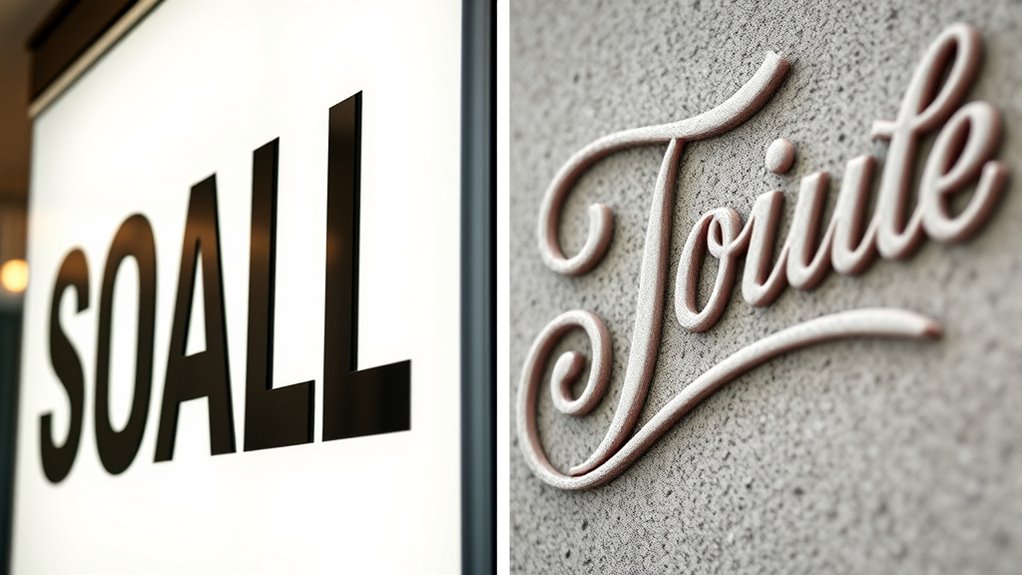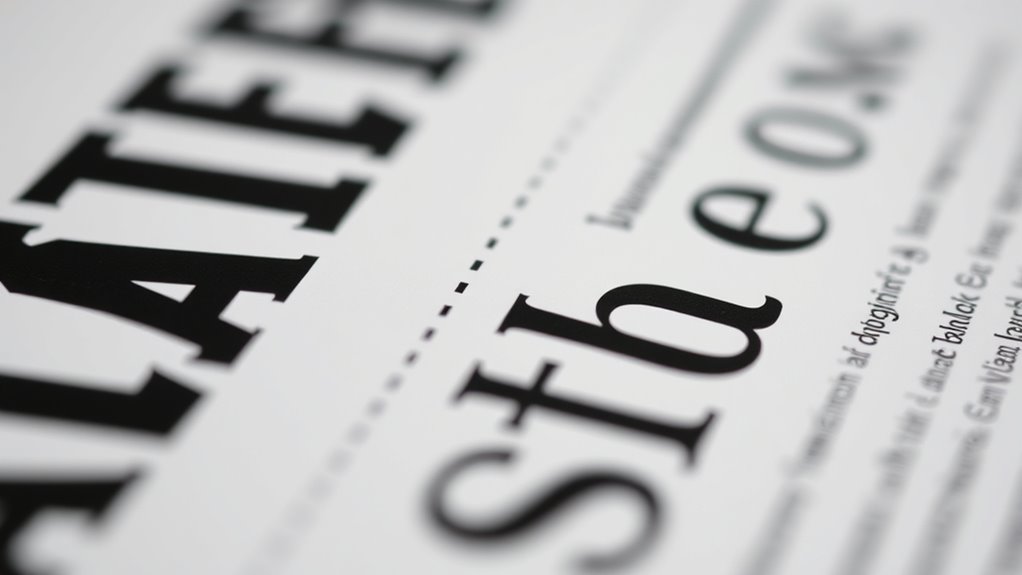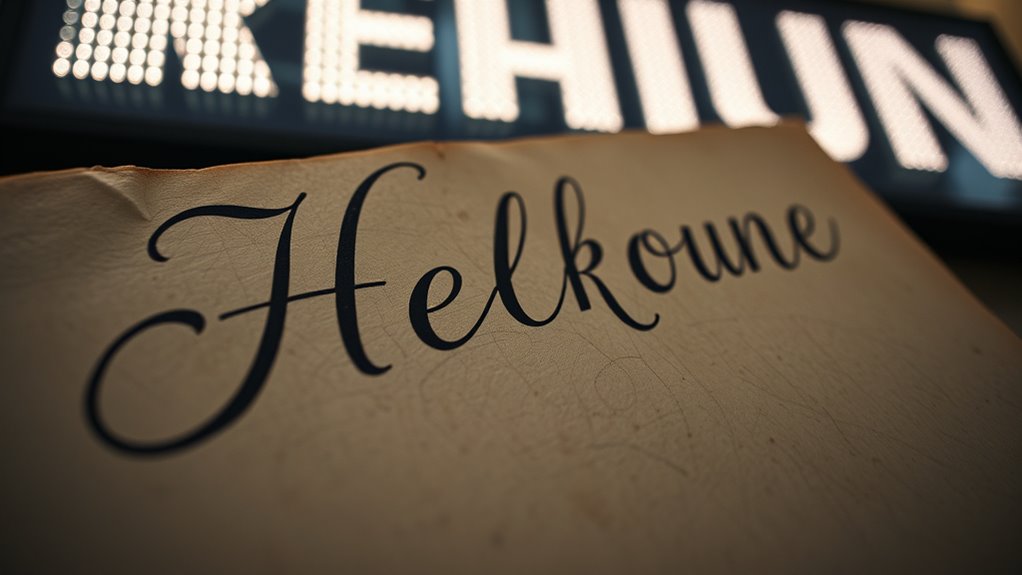Legibility focuses on how easily individual characters and words can be recognized, emphasizing font, size, and contrast. Readability, on the other hand, relates to how well you understand and process entire blocks of text, involving layout and visual flow. While good typography enhances both, understanding their differences helps you optimize design for clarity and comprehension. Keep exploring, and you’ll discover how balancing these aspects improves your communication effectiveness.
Key Takeaways
- Legibility refers to how easily individual characters can be distinguished; readability concerns understanding and processing entire text blocks.
- Good legibility involves clear font, size, and spacing; readability depends on layout, structure, and visual hierarchy.
- Legibility focuses on character clarity; readability emphasizes overall message comprehension and flow.
- Visual factors like font choice and contrast primarily influence legibility; cognitive factors and layout impact readability.
- Enhancing legibility improves character recognition; improving readability facilitates message understanding and engagement.
Defining Legibility and Readability

While the terms legibility and readability are often used interchangeably, they refer to different aspects of how we perceive text. Legibility involves the ease with which individual characters can be distinguished, influenced by font psychology and design choices. For example, certain fonts evoke specific emotions or perceptions, affecting how quickly you recognize letters. Cultural influences also shape your expectations of letterforms and symbols, impacting legibility. Additionally, font design plays a crucial role in enhancing or hindering legibility by optimizing character shapes and spacing. Good font design considers not only aesthetics but also character differentiation, ensuring each letter is distinguishable at a glance. Moreover, understanding the importance of context can help improve overall text comprehension, as it guides your eye and supports interpretation. The visual clarity of text is vital for effective communication, especially in digital displays where screen resolution can affect perception. Readability, on the other hand, relates to how comfortably you can understand and process entire blocks of text. It depends on factors like layout, spacing, and style, which guide your eye smoothly across the content. Together, these concepts determine how effectively a message communicates, but they focus on different layers of your reading experience.
Visual vs. Cognitive Aspects of Text

Understanding text involves both visual and cognitive aspects that work together to create a seamless reading experience. Your eyes process typography nuances such as font choices, spacing, and contrast, which influence how easily you can recognize characters. These visual elements directly affect the effort needed to decode the text. A well-designed layout can significantly improve readability and reduce eye strain, making the reading process more comfortable. On the other hand, cognitive aspects relate to how your mind interprets and understands the information. If the typography is confusing or inconsistent, it increases your cognitive load, making comprehension harder. Balancing visual clarity with cognitive ease ensures your reading remains smooth. When you pay attention to typography nuances, you reduce mental effort and enhance overall readability, allowing you to focus on meaning rather than decoding. Additionally, understanding the core personality traits involved in content design can help create more engaging and user-friendly text layouts. Recognizing the importance of typography in content accessibility can further improve user engagement and comprehension. This synergy between visual and cognitive factors shapes an ideal reading experience, especially when considering the variability of store hours and how clear, well-designed text can help consumers plan their shopping efficiently.
Factors Affecting Legibility

Several factors directly influence legibility, determining how easily you can distinguish and recognize individual characters in a text. Typography trends play a significant role; for example, modern fonts with clean lines and ample spacing improve recognition, while overly decorative fonts hinder it. Cultural influences also shape legibility, as familiarity with certain scripts or styles affects recognition speed. For instance, characters rooted in specific cultural contexts may be more legible within that audience than to outsiders. Additionally, font size, contrast, and spacing directly impact clarity. When these elements align with current typography trends and cultural expectations, your ability to read smoothly increases. Recognizing these factors helps you create or choose text that maximizes legibility, ensuring your message is understood effortlessly. Furthermore, understanding how sound vibrations can influence perception may inspire innovative approaches to visual communication and design. Incorporating visual perception principles from psychology can further enhance how effectively your message is conveyed, especially when considering the impact of cognitive processing on reading comprehension. Being aware of the influence of cultural context on font choices can help tailor your communication to specific audiences, improving overall clarity. Moreover, considering the role of active listening and empathy can improve the way messages are crafted for better understanding.
Elements Influencing Readability

Your choice of font and size can make a big difference in how easily people read your content. Layout and spacing also play vital roles in guiding the reader’s eye and preventing clutter. Understanding these elements helps you design more readable and engaging materials. Additionally, considering scam prevention measures can ensure your content remains trustworthy and reliable for your audience. Incorporating visual hierarchy techniques can further enhance clarity and focus within your layout. Recognizing the importance of self watering plant pots can also inform how you structure your content for better comprehension and appeal. Moreover, leveraging AI-driven solutions in content design can optimize readability and user engagement. As AI models like GPT-4 improve in trustworthiness, they can assist in analyzing and refining your layouts for maximum clarity and impact.
Font Choices and Size
Choosing the right font and size is essential because they directly affect how easily you can process text. Your font size influences readability; too small, and readers strain their eyes, too large, and it feels awkward. Typeface styles also matter—simple, clean fonts like sans-serif are easier to read on screens, while serif fonts can enhance print readability. Selecting appropriate font choices helps establish clarity and focus, guiding readers smoothly through your content. Keep in mind that consistent font size helps maintain visual harmony, preventing distraction or confusion. Avoid overly decorative or complex typeface styles, which can hinder comprehension. Additionally, understanding content accessibility principles can help you make more inclusive design choices, especially considering various reading environments and devices. Being aware of the resources and tools available can further improve your document’s clarity and overall presentation. Recognizing the impact of visual hierarchy can also aid in emphasizing important information and improving overall readability.
Layout and Spacing
How layout and spacing influence readability is essential for guiding your audience through your content smoothly. Proper spacing prevents clutter, making text easier to scan. Use ample margins and line spacing to improve typography contrast, reducing eye strain. Consistent layout helps readers follow your message effortlessly. Color schemes also play a role; contrasting background and text colors enhance clarity. Avoid overcrowding by balancing elements and maintaining whitespace. Clear hierarchy through spacing directs attention to key points. Additionally, mindful use of visual cues can significantly enhance comprehension and retention. Proper content organization ensures that your message is communicated effectively and efficiently. Understanding industry trends related to design and typography can further optimize readability and user engagement. Paying attention to typography principles can help create a more accessible and engaging reading experience. Here’s a visual overview:
| Element | Impact |
|---|---|
| Line Spacing | Improves readability and reduces fatigue |
| Margins & Padding | Creates visual separation and clarity |
| Typography Contrast | Enhances text visibility and focus |
| Color Schemes | Aids comprehension through visual cues |
Thoughtful layout and spacing make your content inviting and easy to read.
Practical Implications for Design

Understanding the distinction between legibility and readability is essential for effective design. When you choose typography, consider current typography trends that emphasize clarity and simplicity to enhance legibility. Be mindful of cultural influences, as font choices and text styles can evoke different meanings and emotional responses across audiences. For example, a font popular in one region might seem outdated or difficult to read elsewhere. To optimize both aspects, select typefaces that balance style with clarity, avoiding overly decorative fonts in body text. Keep cultural sensitivities in mind, ensuring your design communicates clearly without alienating viewers. By attentively applying these considerations, you create interfaces and materials that are both visually appealing and easy to understand, fostering better engagement and comprehension.
Measuring and Improving Both Aspects

You can evaluate legibility and readability through quantitative assessment techniques like readability scores and user testing. Improving these aspects involves visual design enhancements such as clearer typography and better contrast, along with user experience strategies like intuitive layout. By applying these methods, you guarantee your content is both accessible and engaging for your audience.
Quantitative Assessment Techniques
Quantitative assessment techniques provide objective methods for measuring and enhancing both legibility and readability. You can analyze typography clarity by tracking metrics like reading speed, comprehension, or eye movement. These measurements help identify how easily users engage with your content, allowing you to make data-driven improvements. Consider this table:
| Technique | Purpose |
|---|---|
| Readability Scores | Quantifies ease of understanding |
| Eye Tracking | Measures focus and visual flow |
| User Testing | Gathers direct feedback on clarity |
Visual Design Enhancements
Effective visual design directly influences both legibility and readability by guiding how users perceive and process content. To enhance these aspects, focus on current typography trends that prioritize clear, distinguishable fonts, and appropriate spacing. Using modern, legible typefaces ensures text remains accessible across devices and contexts. Additionally, optimizing color contrast is vital; high contrast between text and background improves visibility and reduces strain. Consistently applying these principles helps measure improvements in user comprehension and engagement. Regularly review your design choices to identify areas where legibility or readability may falter, then adjust typography or color schemes accordingly. By emphasizing these visual design enhancements, you create a more accessible and user-friendly experience that effectively communicates your message.
User Experience Strategies
Measuring and improving both legibility and readability requires a strategic approach that combines user feedback with data-driven analysis. You should gather insights on how users perceive your typography psychology, ensuring your font choices support clear comprehension. Regularly test your content against accessibility standards to identify barriers for diverse audiences, including those with visual impairments. Use analytics to track engagement metrics, such as reading time and bounce rates, which reveal how easily users navigate your text. Implement A/B testing for different typography styles to determine which enhance both legibility and readability. Consistently refine your design based on these insights, ensuring your content remains accessible and easy to understand for all users. This balanced approach fosters a better user experience overall.
When to Prioritize Legibility or Readability

Deciding when to prioritize legibility or readability depends on the context and purpose of your text. If your goal is clear communication in a professional or technical setting, prioritizing clarity is essential, especially when considering typography trends that favor simple, clear fonts. For instance, legal documents or medical instructions demand maximum transparency. Conversely, in creative projects or audience-specific content, cultural comprehensibility may influence your choice, where readability becomes more important to engage diverse viewers effectively. Consider your audience’s familiarity with certain styles and reading habits. Use clarity to ensure everyone can decipher your message quickly, while readability helps keep them engaged. Knowing when to emphasize one over the other ensures your message’s effectiveness aligns with your overall communication goals.
Frequently Asked Questions
How Do Cultural Differences Impact Legibility and Readability Perceptions?
Cultural differences shape how you perceive legibility and readability through cultural symbolism and language variations. You might find certain fonts or symbols easier to read because they align with your cultural background, while others may cause confusion. Language differences also influence how quickly you can interpret text. Recognizing these factors helps you design more inclusive content, ensuring it resonates across diverse cultural contexts and enhances overall comprehension.
Can Digital Screens and Print Media Require Different Design Approaches?
You should recognize that digital screens and print media demand different design approaches because typography nuances and color contrast play vital roles. On screens, you need high contrast and scalable fonts to guarantee clarity across devices, while print allows for finer details and richer color palettes. Adjusting typography and color contrast accordingly helps your designs communicate effectively, regardless of medium, ensuring your message remains clear and engaging for your audience.
What Role Does User Familiarity Play in Readability Preferences?
Think of your reading experience as a dance where familiarity guides your steps. When you’re used to certain fonts, like Arial or Times New Roman, your preferences lean towards readability, making text easier to process. Font familiarity acts as a shortcut, reducing cognitive effort and enhancing comprehension. If you’re accustomed to specific styles, you’ll naturally find those more comfortable, highlighting how user familiarity shapes your overall reading experience.
How Do Accessibility Standards Influence Legibility and Readability Design Choices?
You should consider how accessibility standards shape your design choices by emphasizing typography clarity and contrast optimization. These standards guarantee that your content remains legible and readable for all users, including those with visual impairments. You’re encouraged to select high-contrast color schemes and clear typefaces, making your design more inclusive. By following these guidelines, you enhance user experience and ensure your content is accessible to everyone, regardless of their abilities.
Are There Emerging Technologies That Enhance Both Legibility and Readability Simultaneously?
You might be excited to know that emerging technologies like augmented reality and adaptive typography are enhancing both legibility and readability at once. Augmented reality overlays digital information seamlessly onto your environment, making text more accessible. Meanwhile, adaptive typography adjusts font size, style, and spacing in real-time based on user needs, ensuring ideal clarity. These innovations help create more inclusive, engaging experiences that benefit all users by addressing both aspects simultaneously.
Conclusion
Understanding the dance between legibility and readability helps you craft text that truly speaks to your audience. Think of them as two sides of the same coin—balancing clarity and ease of reading. When you prioritize one over the other, you risk your message getting lost like a whisper in the wind. Mastering both guarantees your words shine brightly, guiding readers effortlessly through your message like a lighthouse in a storm.









